Deep Learning Approaches to Image Texture Analysis in Material Processing
Abstract
:1. Introduction
2. Application of Texture Analysis in Metallurgical Engineering
2.1. Geometallurgical Models
2.2. Microstructural Predictors of Metal Properties
2.3. Metal Surface Quality
2.4. Failure Analysis of Metals
3. Analytical Methodology
- (a)
- Generation of two sets of textures A and B that were similar, but not identical. These textures were generated by Voronoi tessellation of random data with user-controlled parameters, and the diagrams were stored as JPG images.
- (b)
- Extraction of features from data textural image sets A and B with each of the algorithms, i.e., GLCM, LBP, textons, AlexNet, VGG19, ResNet50, GoogLeNet and MobileNetV2, described in more detail below.
- (c)
- Use of random forest models to discriminate between the textures using the GLCM, LBP, textons, AlexNet, VGG19, ResNet50, GoogLetNet and MobileNetV2 features as predictors. An exception was made with the trained convolutional neural networks, which were used end-to-end to classify the textures directly.
3.1. Grey Level Co-Occurrence Matrices
3.2. Local Binary Patterns
3.3. Textons
3.4. AlexNet
3.5. VGG19
3.6. ResNet50
3.7. GoogLeNet
3.8. MobileNetV2
4. Case Study 1: Voronoi-Simulated Material Microstructures of Different Grain Size
5. Case Study 2: Voronoi-Simulated Material Microstructures of Different Grain Shape
6. Case Study 3: Real Textures in Ultrahigh Carbon Steel for Material Classification
7. Discussion
8. Conclusions
- Architectures, such as AlexNet, VGG19, GoogLeNet, ResNet50 and MobileNetV2, pretrained on a large public common object image dataset (ImageNet), can be used directly to generate textural descriptors of similar quality as what could be achieved with engineered features, despite the fact that these networks were trained on image data from a different domain.
- As expected, further improvement is possible by partial or full retraining of all the networks. In the case studies considered in this investigation, this resulted in markedly better classification of the different simulated microstructures and the recognition of microstructures of ultrahigh carbon steel under different annealing conditions.
- All the convolutional neural networks performed as well or better than the traditional algorithms (GLCM, LBP and textons). These results are in line with those of other emerging investigations.
- Of the five abovementioned convolutional neural network architectures that were compared in the case studies, GoogLeNet and/or MobileNetV2 yielded the most reliable features. MobileNetV2 would therefore be the preferred approach, given that it trained faster than GoogLeNet.
Author Contributions
Funding
Institutional Review Board Statement
Informed Consent Statement
Data Availability Statement
Conflicts of Interest
Appendix A. Receiver Operating Curves for GoogLeNet and MobileNet in Case Study 3
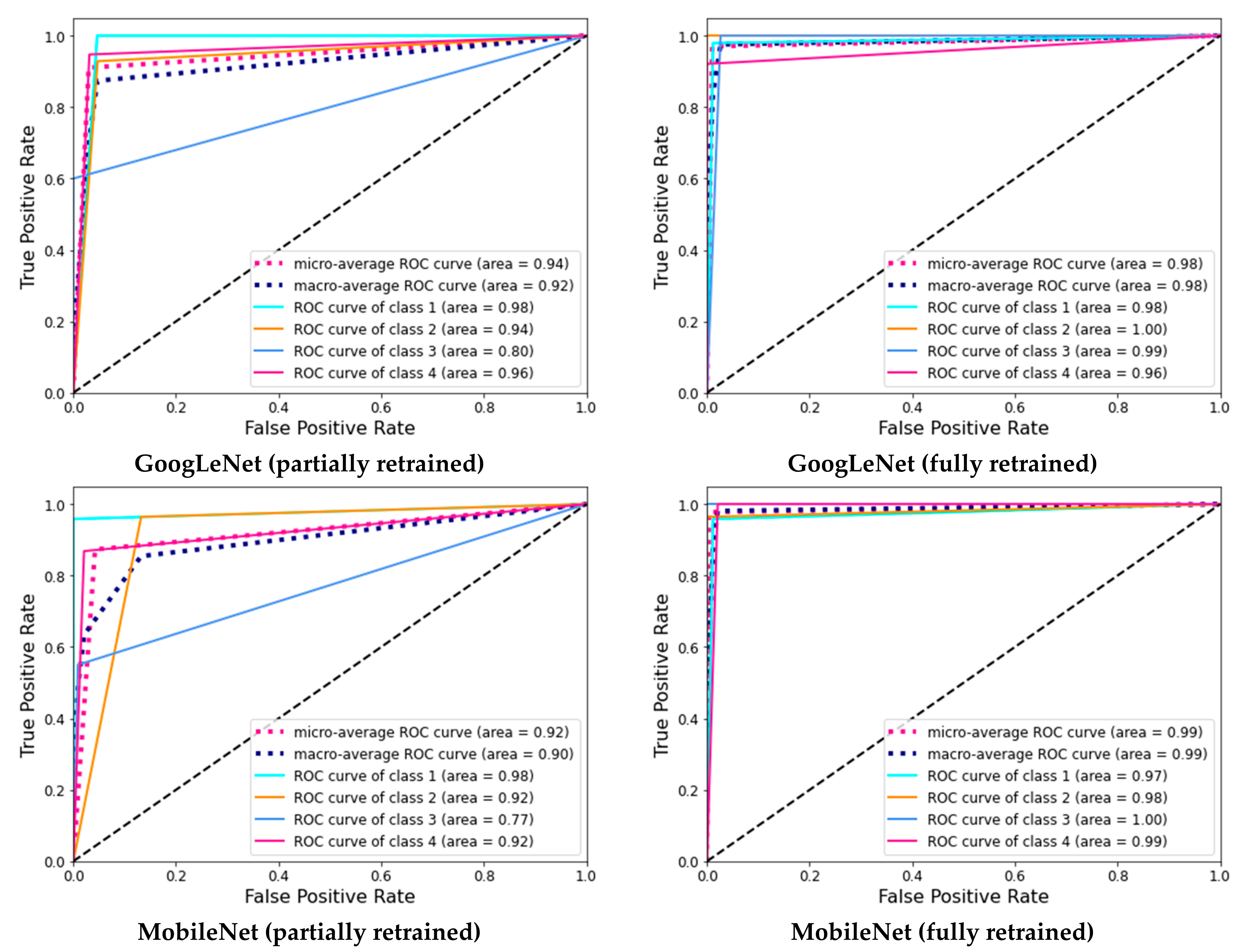
References
- Donskoi, E.; Poliakov, A.; Holmes, R.; Suthers, S.; Ware, N.; Manuel, J.; Clout, J. Iron ore textural information is the key for prediction of downstream process performance. Miner. Eng. 2016, 86, 10–23. [Google Scholar] [CrossRef]
- Jardine, M.A.; Miller, J.A.; Becker, M. Coupled X-ray computed tomography and grey level co-occurrence matrices as a method for quantification of mineralogy and texture in 3D. Comput. Geosci. 2018, 111, 105–117. [Google Scholar] [CrossRef]
- Ghalati, M.K.; Nunes, A.; Ferreira, H.; Serranho, P.; Bernardes, R. Texture Analysis and its Applications in Biomedical Imaging: A Survey. IEEE Rev. Biomed. Eng. 2021, 15, 222–246. [Google Scholar] [CrossRef] [PubMed]
- Kerut, E.K.; Given, M.; Giles, T.D. Review of methods for texture analysis of myocardium from echocardiographic images: A means of tissue characterization. Echocardiography 2003, 20, 727–736. [Google Scholar] [CrossRef]
- Kistner, M.; Jemwa, G.T.; Aldrich, C. Monitoring of mineral processing systems by using textural image analysis. Miner. Eng. 2013, 52, 169–177. [Google Scholar] [CrossRef]
- Razavian, A.S.; Azizpour, H.; Sullivan, J.; Carlsson, S. CNN Features Off-the-Shelf: An Astounding Baseline for Recognition. In Proceedings of the 2014 IEEE Conference on Computer Vision and Pattern Recognition Workshops, Columbus, OH, USA, 23–28 June 2014; pp. 512–519. [Google Scholar]
- Fu, Y.; Aldrich, C. Froth image analysis by use of transfer learning and convolutional neural networks. Miner. Eng. 2018, 115, 68–78. [Google Scholar] [CrossRef]
- Mormont, R.; Geurts, P.; Maree, R. Comparison of Deep Transfer Learning Strategies for Digital Pathology. In Proceedings of the 2018 IEEE/CVF Conference on Computer Vision and Pattern Recognition Workshops (CVPRW), Salt Lake City, UT, USA, 18–23 June 2018; pp. 2343–234309. [Google Scholar]
- Xiao, T.; Liu, L.; Li, K.; Qin, W.; Yu, S.; Li, Z. Comparison of Transferred Deep Neural Networks in Ultrasonic Breast Masses Discrimination. Biomed. Res. Int. 2018, 2018, 4605191. [Google Scholar] [CrossRef]
- Goodall, W.R.; Scales, P.J. An overview of the advantages and disadvantages of the determination of gold mineralogy by automated mineralogy. Miner. Eng. 2007, 20, 506–517. [Google Scholar] [CrossRef]
- Pérez-Barnuevo, L.; Lévesque, S.; Bazin, C. Automated recognition of drill core textures: A geometallurgical tool for mineral processing prediction. Miner. Eng. 2018, 118, 87–96. [Google Scholar] [CrossRef]
- Zhou, J.; Gu, Y. Geometallurgical Characterization and Automated Mineralogy of Gold Ores. In Gold Ore Processing; Adams, M.D., Ed.; Elsevier: Amsterdam, The Netherlands, 2016; pp. 95–111. [Google Scholar]
- Lund, C.; Lamberg, P.; Lindberg, T. A new method to quantify mineral textures for geometallurgy. In Proceedings of the Process Mineralogy; Publisher Geology: Cape Town, South Africa, 2014. [Google Scholar]
- Anderson, K.F.E.; Wall, F.; Rollinson, G.K.; Moon, C.J. Quantitative mineralogical and chemical assessment of the Nkout iron ore deposit, Southern Cameroon. Ore Geol. Rev. 2014, 62, 25–39. [Google Scholar] [CrossRef]
- Jouini, M.S.; Keskes, N. Numerical estimation of rock properties and textural facies classification of core samples using X-ray Computed Tomography images. Appl. Math. Model. 2017, 41, 562–581. [Google Scholar] [CrossRef]
- Tungpalan, K.; Wightman, E.; Manlapig, E. Relating mineralogical and textural characteristics to flotation behaviour. Miner. Eng. 2015, 82, 136–140. [Google Scholar] [CrossRef]
- Parian, M.; Mwanga, A.; Lamberg, P.; Rosenkranz, J. Ore texture breakage characterization and fragmentation into multiphase particles. Powder Technol. 2018, 327, 57–69. [Google Scholar] [CrossRef]
- Voigt, M.; Miller, J.A.; Mainza, A.N.; Bam, L.C.; Becker, M. The Robustness of the Gray Level Co-Occurrence Matrices and X-ray Computed Tomography Method for the Quantification of 3D Mineral Texture. Minerals 2020, 10, 334. [Google Scholar] [CrossRef] [Green Version]
- Partio, M.; Cramariuc, B.; Gabbouj, M.; Visa, A. Rock Texture Retrieval Using Gray Level Co-occurrence Matrix. In Proceedings of the 5th Nordic Signal Processing Symposium (NORSIG 2002), Hurtigruten, Norway, 4–7 October 2002. [Google Scholar]
- Leigh, G.M. Automatic Ore Texture Analysis for Process Mineralogy. In Proceedings of the Ninth International Congress for Applied Mineralogy (ICAM Australia 2008), Brisbane, QLD, Australia, 8–10 September 2008; pp. 433–435. [Google Scholar]
- Koch, P.-H. Particle Generation for Geometallurgical Process Modeling. Ph.D. Thesis, Luleå Tekniska Universitet, Luleå, Sweden, 2017. [Google Scholar]
- Fu, Y.; Aldrich, C. Quantitative Ore Texture Analysis with Convolutional Neural Networks. IFAC-Pap. 2019, 52, 99–104. [Google Scholar] [CrossRef]
- Renzetti, F.R.; Zortea, L. Use of a gray level co-occurrence matrix to characterize duplex stainless steel phases microstructure. Frat. Ed Integrità Strutt. 2011, 5, 43–51. [Google Scholar] [CrossRef] [Green Version]
- Webel, J.; Gola, J.; Britz, D.; Mücklich, F. A new analysis approach based on Haralick texture features for the characterization of microstructure on the example of low-alloy steels. Mater. Charact. 2018, 144, 584–596. [Google Scholar] [CrossRef]
- Velichko, A.; Holzapfel, C.; Siefers, A.; Schladitz, K.; Mücklich, F. Unambiguous classification of complex microstructures by their three-dimensional parameters applied to graphite in cast iron. Acta Mater. 2008, 56, 1981–1990. [Google Scholar] [CrossRef]
- DeCost, B.L.; Francis, T.; Holm, E.A. Exploring the microstructure manifold: Image texture representations applied to ultrahigh carbon steel microstructures. Acta Mater. 2017, 133, 30–40. [Google Scholar] [CrossRef] [Green Version]
- Azimi, S.M.; Britz, D.; Engstler, M.; Fritz, M.; Mucklich, F. Advanced Steel Microstructural Classification by Deep Learning Methods. Sci. Rep. 2018, 8, 2128. [Google Scholar] [CrossRef]
- Gola, J.; Webel, J.; Britz, D.; Guitar, A.; Staudt, T.; Winter, M.; Mücklich, F. Objective microstructure classification by support vector machine (SVM) using a combination of morphological parameters and textural features for low carbon steels. Comput. Mater. Sci. 2019, 160, 186–196. [Google Scholar] [CrossRef]
- Beniwal, A.; Dadhich, R.; Alankar, A. Deep learning based predictive modeling for structure-property linkages. Materialia 2019, 8, 100435. [Google Scholar] [CrossRef]
- Trambitckii, K.; Anding, K.; Polte, G.; Garten, D.; Musalimov, V.; Kuritcyn, P. The application of texture features to quality control of metal surfaces. Acta IMEKO 2016, 5, 19. [Google Scholar] [CrossRef] [Green Version]
- Medeiros, F.N.S.; Ramalho, G.L.B.; Bento, M.P.; Medeiros, L.C.L. On the Evaluation of Texture and Color Features for Nondestructive Corrosion Detection. EURASIP J. Adv. Signal Process. 2010, 2010, 817473–817478. [Google Scholar] [CrossRef] [Green Version]
- Guo, Y.; Sun, Z.; Sun, H.; Song, X. Texture feature extraction of steel strip surface defect based on gray level co-occurrence matrix. In Proceedings of the 2015 International Conference on Machine Learning and Cybernetics (ICMLC), Guangzhou, China, 12–15 July 2015; pp. 217–221. [Google Scholar]
- Luo, Q.; Fang, X.; Sun, Y.; Liu, L.; Ai, J.; Yang, C.; Simpson, O. Surface Defect Classification for Hot-Rolled Steel Strips by Selectively Dominant Local Binary Patterns. IEEE Access 2019, 7, 23488–23499. [Google Scholar] [CrossRef]
- Mao, S.; Natarajan, V.; Chia, L.-T.; Huang, G.-B. Texture Recognition on Metal Surface using Order-Less Scale Invariant GLAC. In Proceedings of the 2019 IEEE 31st International Conference on Tools with Artificial Intelligence (ICTAI), Portland, OR, USA, 4–6 November 2019; pp. 629–635. [Google Scholar]
- Das, P.; Dutta, S.; Roy, H.; Rengaswamy, J. Characterization of Impact Fracture Surfaces Under Different Processing Conditions of 7075 Al Alloy using Image Texture Analysis. Int. J. Technol. Eng. Syst. 2011, 2, 143–147. [Google Scholar]
- Dutta, S.; Das, A.; Barat, K.; Roy, H. Automatic characterization of fracture surfaces of AISI 304LN stainless steel using image texture analysis. Measurement 2012, 45, 1140–1150. [Google Scholar] [CrossRef]
- Dutta, S.; Barat, K.; Das, A.; Das, S.K.; Shukla, A.K.; Roy, H. Characterization of micrographs and fractographs of Cu-strengthened HSLA steel using image texture analysis. Measurement 2014, 47, 130–144. [Google Scholar] [CrossRef]
- Naik, D.L.; Kiran, R. Identification and characterization of fracture in metals using machine learning based texture recognition algorithms. Eng. Fract. Mech. 2019, 219, 106618. [Google Scholar] [CrossRef]
- Müller, A.; Karathanasopoulos, N.; Roth, C.C.; Mohr, D. Machine Learning Classifiers for Surface Crack Detection in Fracture Experiments. Int. J. Mech. Sci. 2021, 209, 106698. [Google Scholar] [CrossRef]
- Bastidas-Rodriguez, M.X.; Prieto-Ortiz, F.A.; Espejo, E. Fractographic classification in metallic materials by using computer vision. Eng. Fail. Anal. 2016, 59, 237–252. [Google Scholar] [CrossRef]
- Dutta, S.; Karmakar, A.; Roy, H.; Barat, K. Automatic estimation of mechanical properties from fractographs using optimal anisotropic diffusion and Voronoi tessellation. Measurement 2019, 134, 574–585. [Google Scholar] [CrossRef]
- Haralick, R.M.; Shanmugam, K.; Dinstein, I.H. Textural Features for Image Classification. IEEE Trans. Syst. Man Cybern. 1973, SMC-3, 610–621. [Google Scholar] [CrossRef] [Green Version]
- Moolman, D.W.; Aldrich, C.; van Deventer, J.S.J.; Stange, W.W. Digital image processing as a tool for on-line monitoring of froth in flotation plants. Miner. Eng. 1994, 7, 1149–1164. [Google Scholar] [CrossRef]
- Moolman, D.W.; Aldrich, C.; van Deventer, J.S.J. The monitoring of froth surfaces on industrial flotation plants using connectionist image processing techniques. Miner. Eng. 1995, 8, 23–30. [Google Scholar] [CrossRef]
- Moolman, D.W.; Aldrich, C.; van Deventer, J.S.J.; Bradshaw, D.J. The interpretation of flotation froth surfaces by using digital image analysis and neural networks. Chem. Eng. Sci. 1995, 50, 3501–3513. [Google Scholar] [CrossRef]
- Ojala, T.; Pietikäinen, M.; Harwood, D. A comparative study of texture measures with classification based on featured distributions. Pattern Recognit. 1996, 29, 51–59. [Google Scholar] [CrossRef]
- Mansano, M.; Pavesi, L.; Oliveira, L.S.; Britto, A.; Koerich, A. Inspection of metallic surfaces using Local Binary Patterns. In Proceedings of the IECON 2011—37th Annual Conference of the IEEE Industrial Electronics Society, Melbourne, VIC, Australia, 7–10 November 2011; pp. 2227–2231. [Google Scholar]
- Fu, Y.; Aldrich, C. Flotation Froth Image Analysis by Use of a Dynamic Feature Extraction Algorithm. IFAC-PapersOnLine 2016, 49, 84–89. [Google Scholar] [CrossRef]
- Aldrich, C.; Smith, L.K.; Verrelli, D.I.; Bruckard, W.J.; Kistner, M. Multivariate image analysis of realgar–orpiment flotation froths. Mineral. Process. Extr. Metall. 2017, 127, 146–156. [Google Scholar] [CrossRef]
- Aldrich, C.; Uahengo, F.D.L.; Kistner, M. Estimation of particle size in hydrocyclone underflow streams by use of Multivariate Image Analysis. Miner. Eng. 2015, 70, 14–19. [Google Scholar] [CrossRef]
- Leung, T.; Malik, J. Representing and Recognizing the Visual Appearance of Materials using Three-dimensional Textons. Int. J. Comput. Vis. 2001, 43, 29–44. [Google Scholar] [CrossRef]
- Schmid, C. Constructing models for content-based image retrieval. In Proceedings of the 2001 IEEE Computer Society Conference on Computer Vision and Pattern Recognition (CVPR 2001), Kauai, HI, USA, 8–14 December 2001; pp. 39–45. [Google Scholar]
- Varma, M.; Zisserman, A. A statistical approach to material classification using image patch exemplars. IEEE Trans. Pattern. Anal. Mach. Intell. 2009, 31, 2032–2047. [Google Scholar] [CrossRef]
- Jemwa, G.T.; Aldrich, C. Estimating size fraction categories of coal particles on conveyor belts using image texture modeling methods. Expert Syst. Appl. 2012, 39, 7947–7960. [Google Scholar] [CrossRef]
- Krizhevsky, A.; Sutskever, I.; Hinton, G.E. ImageNet classification with deep convolutional neural networks. Commun. ACM 2017, 60, 84–90. [Google Scholar] [CrossRef]
- Szegedy, C.; Liu, W.; Jia, Y.; Sermanet, P.; Reed, S.; Anguelov, D.; Erhan, D.; Vanhoucke, V.; Rabinovich, A. Going Deeper with Convolutions. In Proceedings of the 2015 IEEE Conference on Computer Vision and Pattern Recognition (CVPR), Boston, MA, USA, 7–12 June 2015; pp. 1–9. [Google Scholar]
- Sandler, M.; Howard, A.; Zhu, M.; Zhmoginov, A.; Chen, L.-C. MobileNetV2: Inverted Residuals and Linear Bottlenecks. In Proceedings of the 2018 IEEE/CVF Conference on Computer Vision and Pattern Recognition (CVPR), Salt Lake City, UT, USA, 18–23 June 2018; pp. 4510–4520. [Google Scholar]
- Kingma, D.P.; Ba, J. Adam: A Method for Stochastic Optimization. In Proceedings of the Published as a Conference Paper at the 3rd International Conference on Learning Representations, San Diego, CA, USA, 7–9 May 2015. [Google Scholar]
- Hinton, G.; Roweis, S. Stochastic Neighbor Embedding. Adv. Neural Inf. Process. Syst. 2003, 15, 857–864. [Google Scholar]
- van Der Maaten, L.; Hinton, G. Visualizing data using t-SNE. J. Mach. Learn. Res. 2008, 9, 2579–2625. [Google Scholar]
- DeCost, B.L.; Hecht, M.D.; Francis, T.; Webler, B.A.; Picard, Y.N.; Holm, E.A. UHCSDB: UltraHigh Carbon Steel Micrograph DataBase. Integr. Mater. Manuf. Innov. 2017, 6, 197–205. [Google Scholar] [CrossRef]
- Bhatt, A.; Ganatra, A.; Kotecha, K. COVID-19 pulmonary consolidations detection in chest X-ray using progressive resizing and transfer learning techniques. Heliyon 2021, 7, e07211. [Google Scholar] [CrossRef]
- Andrearczyk, V.; Whelan, P.F. Using filter banks in Convolutional Neural Networks for texture classification. Pattern. Recognit. Lett. 2016, 84, 63–69. [Google Scholar] [CrossRef] [Green Version]
- Wu, H.; Yan, W.; Li, P.; Wen, Z. Deep Texture Exemplar Extraction Based on Trimmed T-CNN. IEEE Trans. Multimed. 2021, 23, 4502–4514. [Google Scholar] [CrossRef]
- Lin, T.; RoyChowdhury, A.; Maji, S. Bilinear CNN Models for Fine-Grained Visual Recognition. In Proceedings of the 2015 IEEE International Conference on Computer Vision (ICCV), Santiago, Chile, 11–18 December 2015; pp. 1449–1457. [Google Scholar]
- Zhang, H.; Xue, J.; Dana, K. Deep TEN: Texture Encoding Network. In Proceedings of the 2017 IEEE Conference on Computer Vision and Pattern Recognition (CVPR), Honolulu, HI, USA, 21–26 July 2017; pp. 2896–2905. [Google Scholar]
- Joshi, G.; Walambe, R.; Kotecha, K. A Review on Explainability in Multimodal Deep Neural Nets. IEEE Access 2021, 9, 59800–59821. [Google Scholar] [CrossRef]
- Pilania, G. Machine learning in materials science: From explainable predictions to autonomous design. Comput. Mater. Sci. 2021, 193, 110360. [Google Scholar] [CrossRef]


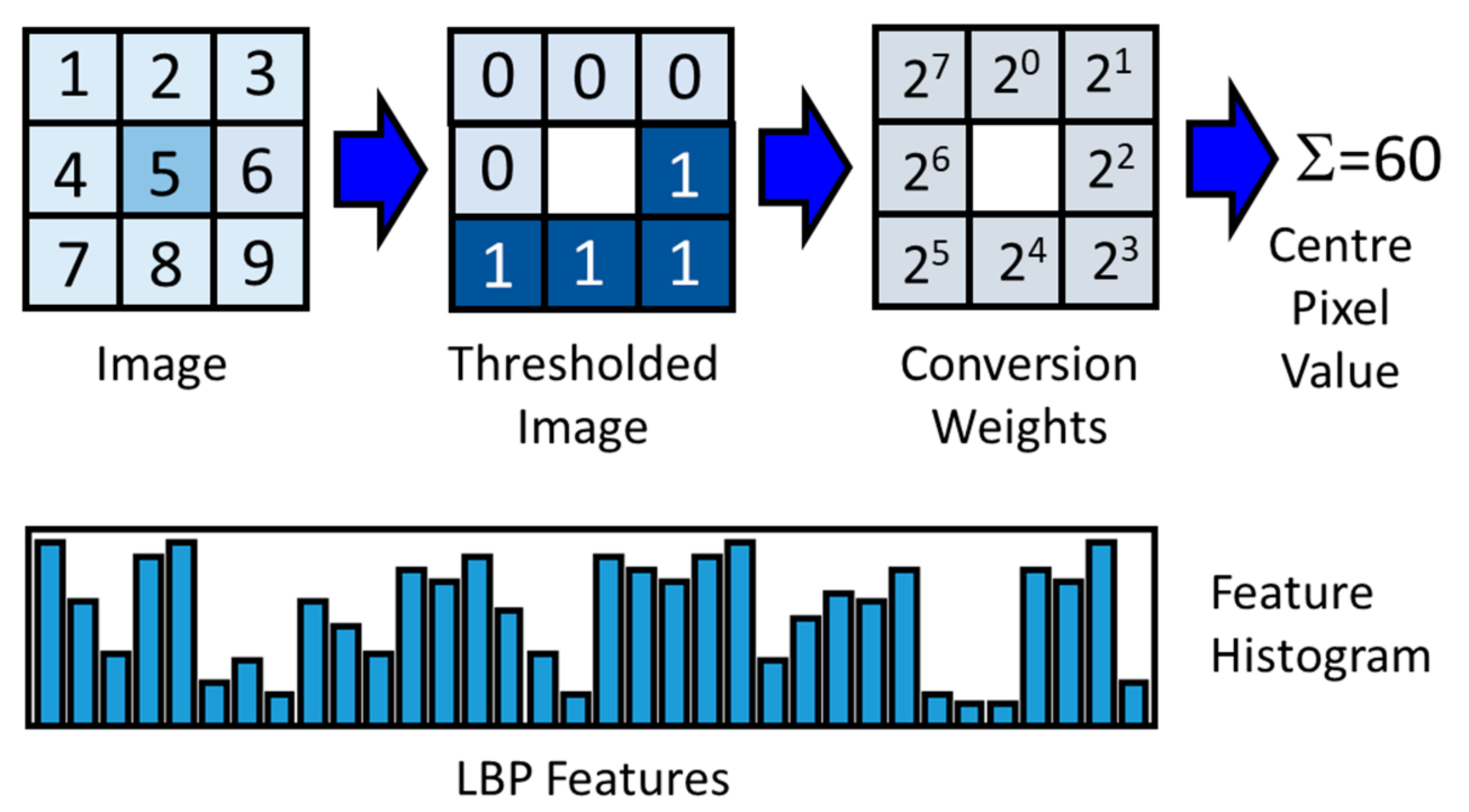



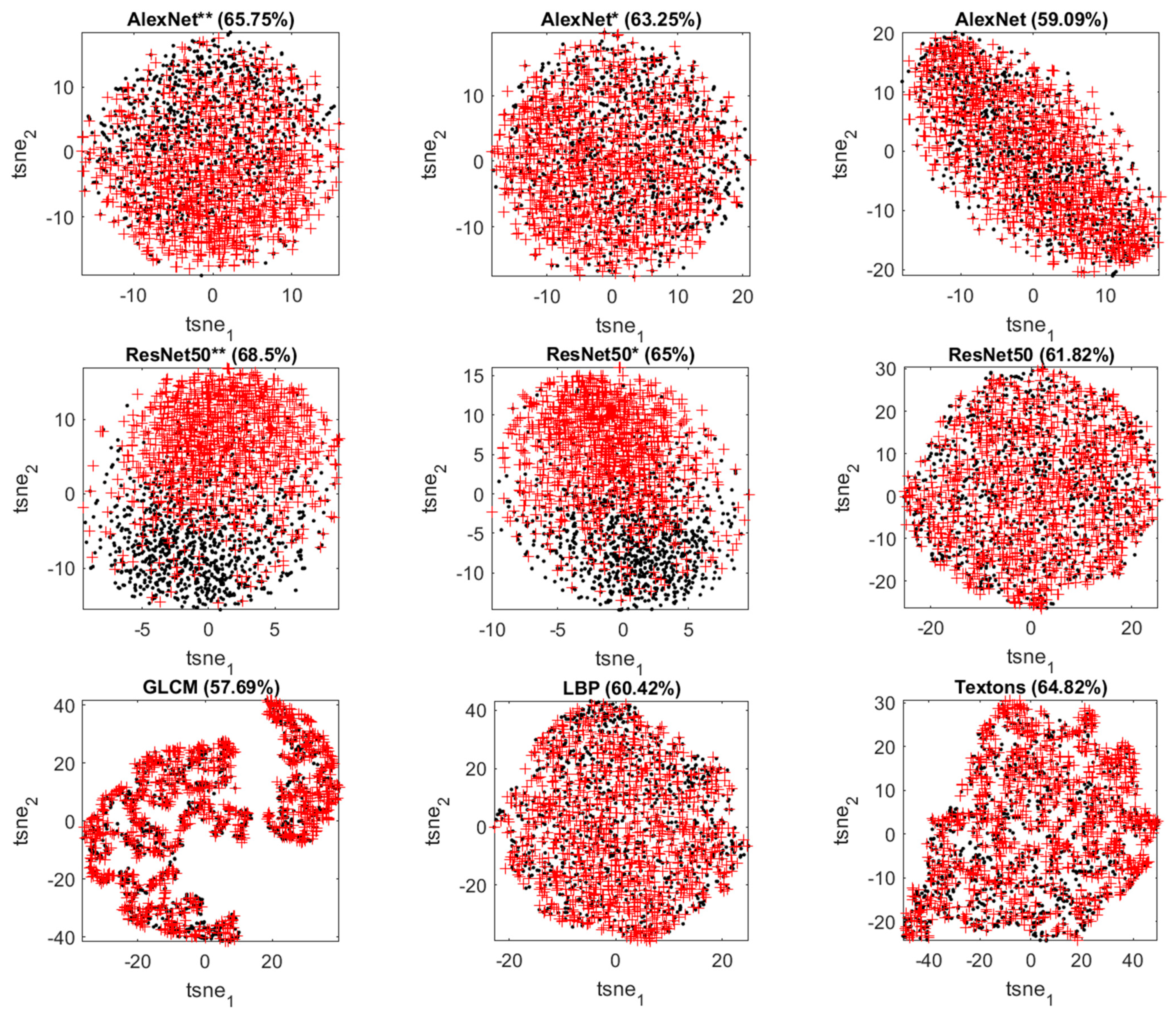
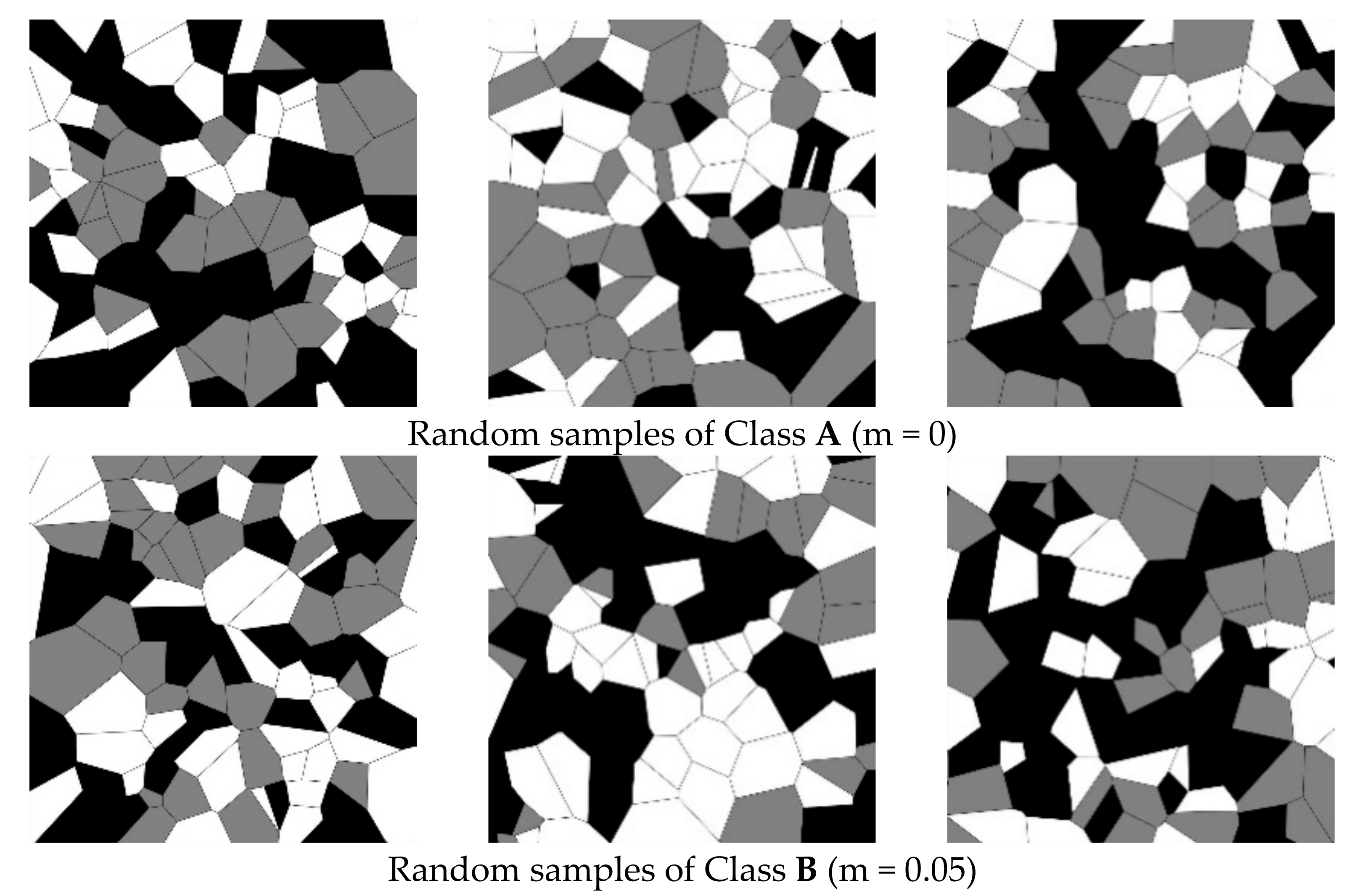


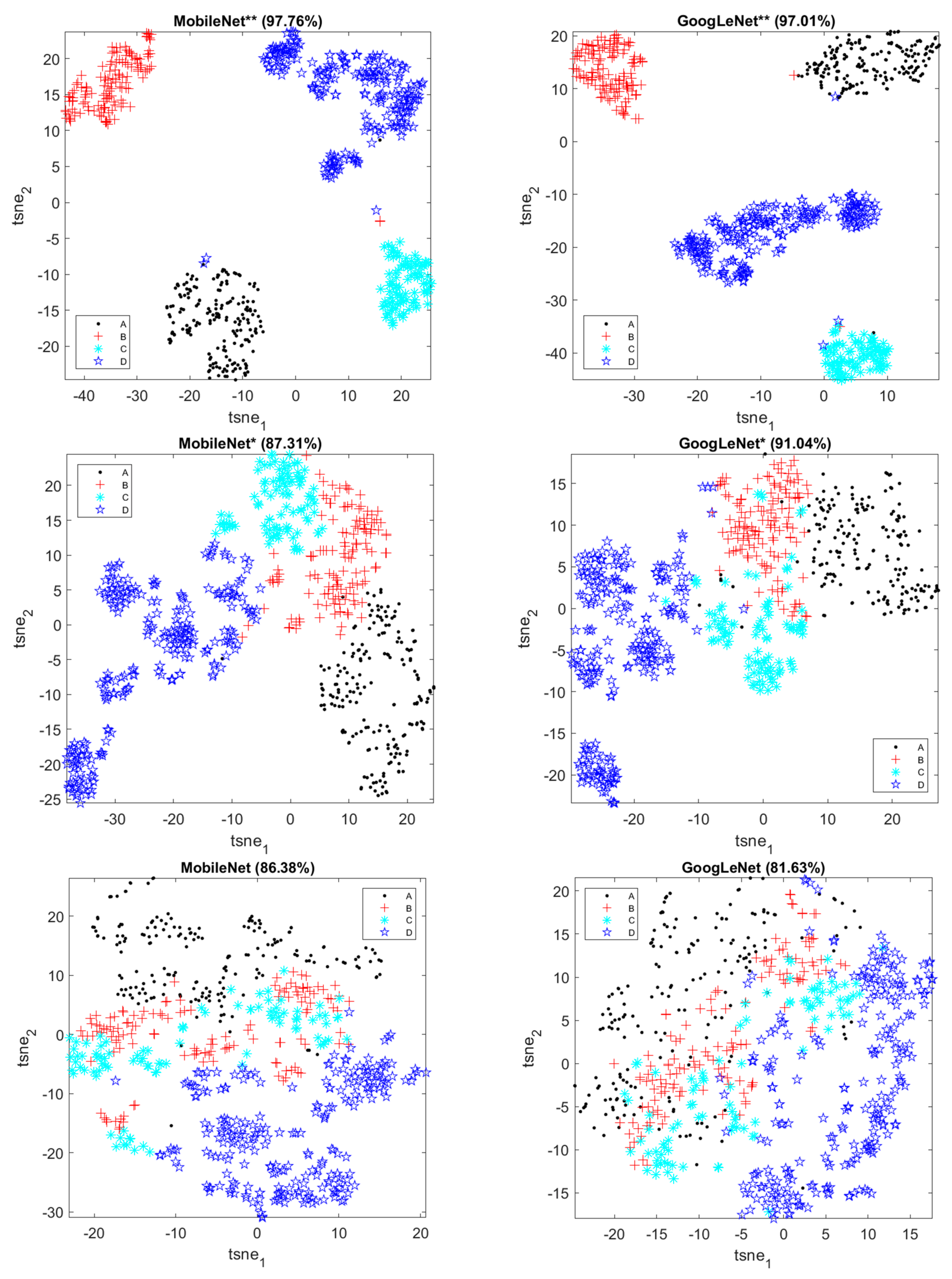

| Network | Depth | Parameters (Millions) | Features |
|---|---|---|---|
| AlexNet | 8 | 61 | 4096 |
| VGG19 | 19 | 144 | 4096 |
| ResNet50 | 50 | 25.6 | 2048 |
| GoogLeNet | 22 | 7 | 1024 |
| MobileNetV2 | 53 | 3.4 | 1280 |
| Hyperparameter | Description | Value |
|---|---|---|
| Number of trees | 500 | |
| Percentage of observations drawn at each split | ||
| Number of variables drawn at each split | ||
| Replacement | TRUE/FALSE | TRUE |
| Node Size | Minimum number of samples in a terminal node | 1 |
| Splitting rule | Criterion on which splitting of nodes is based | Gini |
| Model | Number of Features | Accuracy (%) Test Data |
|---|---|---|
| GLCM | 4 | 57.69 |
| LBP | 59 | 60.42 |
| Textons | 20 | 64.82 |
| AlexNet | 4096 | 59.09 |
| VGG19 | 4096 | 58.29 |
| GoogLeNet | 1024 | 55.21 |
| ResNet50 | 2048 | 61.82 |
| MobileNetV2 | 1280 | 57.60 |
| AlexNet * | 4096 | 63.25 |
| VGG19 * | 4096 | 66.75 |
| GoogLeNet * | 1024 | 64.00 |
| ResNet50 * | 2048 | 65.00 |
| MobileNetV2 * | 1280 | 62.75 |
| AlexNet ** | 4096 | 65.75 |
| VGG19 ** | 4096 | 73.50 |
| GoogLeNet ** | 1024 | 74.25 |
| ResNet50 ** | 2048 | 68.50 |
| MobileNetV2 ** | 1280 | 69.50 |
| Model | Number of Features | Accuracy (%) Test Data |
|---|---|---|
| Textons | 20 | 55.74 |
| GoogLeNet | 1024 | 54.11 |
| MobileNetV2 | 1280 | 53.54 |
| GoogLeNet * | 1024 | 63.25 |
| MobileNetV2 * | 1280 | 64.75 |
| GoogLeNet ** | 1024 | 72.25 |
| MobileNetV2 ** | 1280 | 70.75 |
| Model | Number of Features | Accuracy (%) Test Data |
|---|---|---|
| Textons | 20 | 85.35 |
| GoogLeNet | 1024 | 81.63 |
| MobileNetV2 | 1280 | 86.38 |
| GoogLeNet * | 1024 | 91.04 |
| MobileNetV2 * | 1280 | 87.31 |
| GoogLeNet ** | 1024 | 97.01 ± 2.36 (s.d.) |
| MobileNetV2 ** | 1280 | 97.76 ± 2.14 (s.d.) |
| Confusion Matrix | Predicted | ||||
|---|---|---|---|---|---|
| A | B | C | D | ||
| Actual | A | 46 | 0 | 0 | 2 |
| B | 1 | 27 | 0 | 0 | |
| C | 0 | 0 | 20 | 0 | |
| D | 0 | 0 | 0 | 38 | |
Publisher’s Note: MDPI stays neutral with regard to jurisdictional claims in published maps and institutional affiliations. |
© 2022 by the authors. Licensee MDPI, Basel, Switzerland. This article is an open access article distributed under the terms and conditions of the Creative Commons Attribution (CC BY) license (https://creativecommons.org/licenses/by/4.0/).
Share and Cite
Liu, X.; Aldrich, C. Deep Learning Approaches to Image Texture Analysis in Material Processing. Metals 2022, 12, 355. https://doi.org/10.3390/met12020355
Liu X, Aldrich C. Deep Learning Approaches to Image Texture Analysis in Material Processing. Metals. 2022; 12(2):355. https://doi.org/10.3390/met12020355
Chicago/Turabian StyleLiu, Xiu, and Chris Aldrich. 2022. "Deep Learning Approaches to Image Texture Analysis in Material Processing" Metals 12, no. 2: 355. https://doi.org/10.3390/met12020355
APA StyleLiu, X., & Aldrich, C. (2022). Deep Learning Approaches to Image Texture Analysis in Material Processing. Metals, 12(2), 355. https://doi.org/10.3390/met12020355






